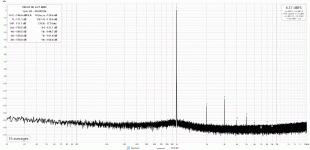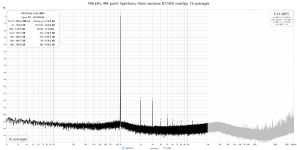Inspired by EigenTakt D-class amplifier by Bruno Putzeys and Lars Risbo,
I got very curious if it is possible to build self-oscillating DAC.
Few weeks I was struggling to understand how to implement a loop filter with proper frequency response.
It turns to be of 9th order.
I didn't read the Bruno's patents.
Understanding this official "pidgin-lawyer's" language is far beyond the scope of my intelligence.
So, I simply started playing with Bode diagrams using "trial and error" approach, playing with zeros and poles.
Than carefully transferred the result into digital domain by using Z-transform.
Fortunately, there was no problem with hardware. I used a prototype of my FPGA DAC.
Only FPGA configuration was updated.
The performance of the EigenDAC is quite impressive but still not as good as my traditional PWM-SDM.
1) Bode plot.
2) Animated THD @ 0..-100dBc.
3) Wide band 20-384k noise+distortions @ 0dBc
I got very curious if it is possible to build self-oscillating DAC.
Few weeks I was struggling to understand how to implement a loop filter with proper frequency response.
It turns to be of 9th order.
I didn't read the Bruno's patents.
Understanding this official "pidgin-lawyer's" language is far beyond the scope of my intelligence.
So, I simply started playing with Bode diagrams using "trial and error" approach, playing with zeros and poles.
Than carefully transferred the result into digital domain by using Z-transform.
Fortunately, there was no problem with hardware. I used a prototype of my FPGA DAC.
Only FPGA configuration was updated.
The performance of the EigenDAC is quite impressive but still not as good as my traditional PWM-SDM.
1) Bode plot.
2) Animated THD @ 0..-100dBc.
3) Wide band 20-384k noise+distortions @ 0dBc
Attachments
Last edited:


